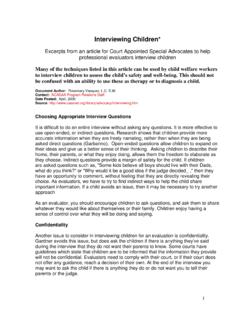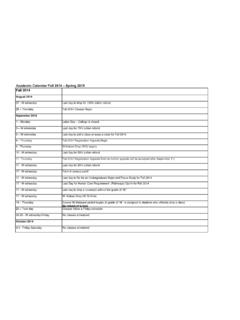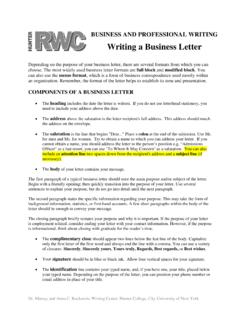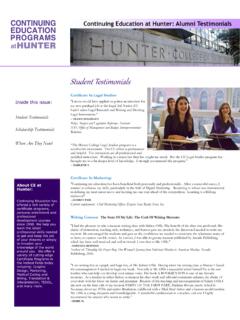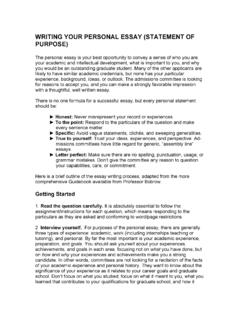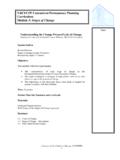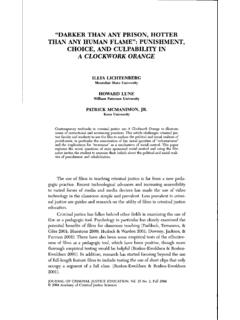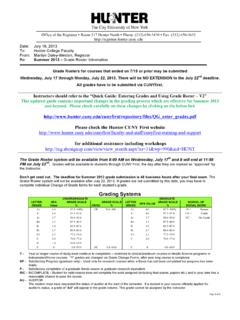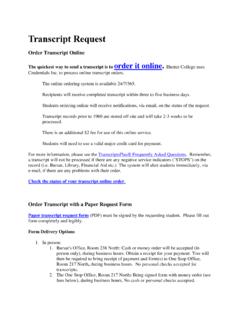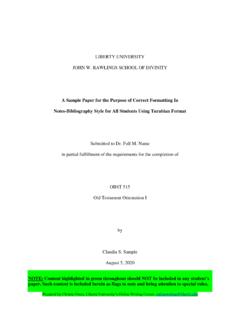Transcription of MLA Documentation Style Newest Version
1 THE DOCUMENTED ESSAY MLA Documentation Style MLA Style is a system for documenting sources in scholarly writing, primarily in the liberal arts and humanities, recommended by the Modern Language Association (MLA). In MLA Documentation Style , you acknowledge your sources by using parenthetical citations in your text that correspond to an alphabetical list of works that appears at the end of your research paper. The list titled Works Cited identifies the sources you used in your research. Each entry in the list of works cited is made up of core elements given in a specific order. Note that a citation in MLA Style contains only enough information to enable readers to find the source in the list of works cited. FORMATTING GUIDELINES Unless your instructor has specific requirements for the format of your research paper, the most common formatting for 8 x 11 inch paper is to leave one inch margins at the top and bottom and on both sides of the text.
2 Always choose an easily readable typeface, such as Times New Roman, and set it to a standard size, usually 12 points. Do not justify the lines of text at the right margin; turn off any automatic hyphenation feature in your writing program. Double-space the entire paper, including quotations, notes, and the list of works cited. Indent the first line of a paragraph as well as set-off quotations half an inch from the left margin. Leave one space after a period or other concluding punctuation mark, unless your instructor prefers two spaces. A research paper does not need a title page. Instead, beginning one inch from the top of the first page and flush with the left margin, type your name, your instructor s name, the course number , and the date on separate lines, double-spacing the lines.
3 On a new, double-spaced line, center the title. Do not italicize or underline your title; put it in quotation marks or boldface, or type it in all capital letters. number all pages , including the title page, consecutively throughout the research paper in the upper right-hand corner, half an inch from the top and flush with the right margin. Type your last name, followed by a space, before each page number . IN-TEXT CITATION 2 MLA Style format follows the author-page method of in-text citation to identify quotations, ideas, or information derived from other sources. A basic in-text citation consists of the last name of the author and a page number . Note that abbreviations (p. or pp.) are not used in in-text citations. For direct quotation, the parenthetical citation directly follows the closing quotation mark: The author states that an inventory of the physical and material progress of printing until the year 1500 would reveal more than 1,100 shops in 200 cities, in which some 12,000,000 books, in 35,000 editions, had been produced (Chappell 84).
4 For a paraphrase, put the citation in a place where a natural pause would usually occur (preferably at the end of a sentence) or as near to the cited material as possible. Note that the period that would normally end the quoted or paraphrased material should be placed after the parenthetical citation: Author Warren Chappell states that by the year 1500 at least 12 million books had been produced (84). In-text citations should direct a reader to the corresponding entry in the list of works cited. The name or title that appears in the parenthetical citation should begin the entry in the works-cited list as follows: Chappell, Warren. A Short History of the Printed Word. Nonpareil Books, 1980. SAMPLE IN-TEXT CITATIONS A Work by a Single Author: the standard parenthetical notation includes the last name of the author and page number (s) of the specific quoted or paraphrased material.
5 One modern researcher has found that dreams move backward in time as the night progresses, that they gradually turn from the contemporary world to childhood and stored images (Dement 71). If the author s name is mentioned in the sentence, then include only the page number in the parenthetical citation. Sigmund Freud states that a dream is the fulfillment of a wish (154). If the author is unknown, use the title or a shortened Version of the title in place of a name. 3 In the poem, Grendel is defeated and Beowulf fulfils his boast: The man who had lately landed among them, proud and sure, had purged the hall, kept it from harm (Beowulf 55). Work Cited Beowulf. Translated by Seamus Heaney, Farrar, Straus and Giroux, 2000. A Work by Two Authors: include the last names of the authors in the order they are listed in the source.
6 For all their efforts to generalize about child behavior, psychologists recognize that no two children are exactly alike (Gesell and Ilg 68). A Work by Three or More Authors: include the last name of the first author and replace the additional names with et al. ( and others ). The relationships between words and their meanings are much more complex than they seem (Plag et al. 140). Two or More Works by the Same Author: include the title of individual works in your citation. You may use a shortened Version of titles for brevity s sake. Be sure to use italics or quotation marks as appropriate for titles. Modern dream researchers now accept the principle that dreams express profound aspects of personality (Foulkes, Sleep 184). Yet Foulkes himself has found that young children s dreams are in general rather simple and unemotional ( Dreams 78).
7 A Work by a Corporate or Government Author or Organization: use the name of the corporate or government author or organization ( , Public Agenda Foundation) or a commonly shortened Version of the name ( , PAF) as the author in your citation. By 1992 it was apparent that the American health care system, though impressive in many ways, needed to be fixed and perhaps radically modified (Public Agenda Foundation 4). A Work from an Indirect Source: give the name of the author of the original work in your text and write qtd. in (quoted in) followed by the name of the author of the source you consulted. 4 In The Civilization of the Renaissance in Italy, Jakob Burchhardt gives an interesting picture of the libraries and the copyists at the time of the incunabula, those first printed books: At Urbino there were catalogues of the libraries of the Vatican, of St.
8 Mark at Florence, of the Visconti at Pavia, and even the library at Oxford (qtd. in Chappell 35). Note: The corresponding entry in the list of works cited will begin with the author or title of the source consulted (see above under Chappell). A Quotation from a Work of Prose: if a quotation ending a sentence requires a parenthetical reference, place the sentence period after the reference. For Charles Dickens the eighteenth century was both the best of times and the worst of times (35). Note: If a quotation extends to more than four lines within your text, set it off from your text by beginning a new line, indenting one inch from the left margin, and typing it double-spaced, without adding quotation marks. The quotation is generally introduced by a colon, and the parenthetical reference for a prose quotation is set off from the text following the last line of the quotation.
9 A Quotation from a Poem: cite by part (if applicable) and line(s), separated by a period. Include up to three lines of poetry within your text, separated by a slash with a space on each side ( / ). In Robert Frost s poem The Death of the Hired Man, one character describes home as the place where, when you have to go there, / They have to take you in (118-19). Quotations of more than three lines should begin on a new line. Unless the quotation involves unusual spacing, indent each line one inch from the left margin and double-space between lines, introduced by a colon and not with quotation marks. Elizabeth Bishop s In the Waiting Room is rich in evocative detail: It was winter. It got dark early. The waiting room was full of grown-up people, arctics and overcoats, lamps and magazines.
10 (6-10) 5 Note: For titles of poems, use quotation marks, except for book-length poems, which are italicized ( , Beowulf, Homer s Iliad, Milton s Paradise Lost). Quotation from a Play with Act, Scene, and Line Numbers: cite by title (italicized and often abbreviated, , Mac. for Macbeth, Mis. for Moli re s Le misanthrope) followed by Arabic numerals separated by periods. Independent lines of quoted text are separated by a slash with a space on each side ( / ). Indent longer quotations one inch from the margin. Claiming All the world s a stage / And all the men and women merely players ( ), the character of Jaques, in As You Like It, presents a gloomy view of the human condition. However, Macbeth s perspective is even more pessimistic: Out, out, brief candle!
